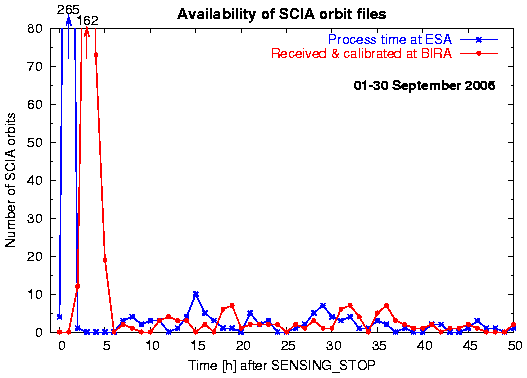| |
Near-real time SO2 data service
On 27 September 2006 the near-real time (NRT) processing of SO2 slant column
data based on SCIAMACHY observations for both the Volcanic & Air Quality
Services was made available. Maps based on OMI data are presented in NRT
since 8 November 2007, and maps based on GOME-2 data since
13 February 2008.
Links to the data sets are given above. The term "near-real time" usually means:
within 3 to 6 hours after observation.
Based on the SCIAMACHY data, the system also sends notifications of exceptional SO2 concentrations by email to users who have subscribed to that service; see
this page for an introduction and description of what is provided by the notification service.
This NRT service provides data and images to the website. For this service,
only data files and images with the data on satellite orbit coordinates are
provided. The software processes incoming SCIAMACHY level-1 and GOME-2 level-2 files in NRT. this service provide SCIAMACHY, GOME-2, OMI, IASI and AIRS level-3 in NRT.
By far most SCIAMACHY orbits are processed within about 3 hours after
observation. But a few orbit from the beginning of the day (in terms of UTC)
often arrive later than orbit from the middle or end of that day -- this is
due to the late delivery of the data by the ground data network.
Images in the near-real time service
The data services based on SCIAMACHY, GOME-2 and OMI data provide images of the SO2 Vertical
Columns Densities (VCD), of the Absorbing Aerosol Index (AAI) and of the Cloud Cover Fraction (CCF). SO2 Slant Columns Densities (SCD) are initially processed for SCIAMACHY and GOME-2 data. In order to convert the SCD into the VCD, informations on the clouds are used. The presence or the abcense of clouds can give an indication of the thickness of the SO2 plume observed in VCD.
The data services based on IASI ans AIRS data provide images of the SO2 Differences of Brightness Temperature (DBT).
In the NRT service, things are a little different. Since the main goal
of the NRT service is to give information on the location of SO2 peak
values possibly related to volcanic eruptions (or anthropogenic activities),
it is not necessary that the values are exact. To at least have an idea
of where SO2 peaks are related and a rough estimate of the total column of
SO2 in the absence of cloud information, the VCD is calculated assuming
clear-sky conditions, i.e. the absence of any clouds.
For OMI data there is no real SCD available, as the SO2 concentration is
derived in a different way. Therefore only images of the VCD and CCF are
available. See this link for more information about OMI.
Process monitoring
Processing of SCIAMACHY data is currently done at BIRA-IASB.
The service is run on a best-effort basis, without much process
monitoring, as the service is still in an experimental stage.
The graph below gives an indication of the time between the measurement
and the availability of the data.
Processing of OMI data is done by NASA/NOAA and the level-2 data is
delivered in NRT to KNMI, where the plotting is done in NRT.

|
|
Graph showing how many SCIAMACHY orbit files are available as function
of the hours after the end of the measurements along that orbit.
The blue curve gives the time it took ESA to process the raw data and
prepare the level-1b spectrum files. Once the these files are made, they are
made available to, among others, KNMI. From KNMI they are pushed to
BIRA-IASB, where they are picked up and calibrated (to form level-1c files)
for the retrieval of trace gases, such as NO2, SO2 and BrO. The red curve
shows the time to took for that step to be finished.
|
|
|